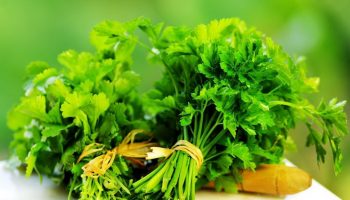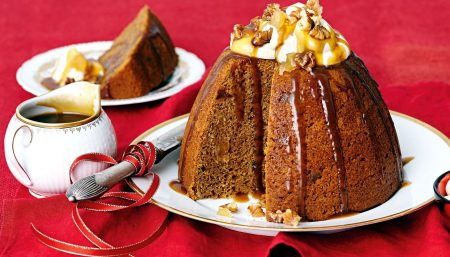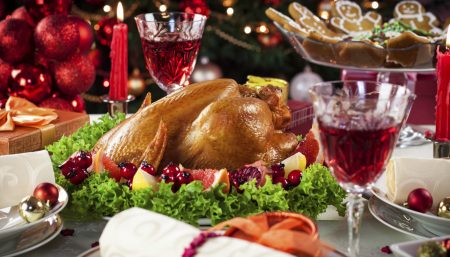Old customs and legends have connected many herbs with Christmas and make them especially appropriate for the Advent and Christmas seasons. The natural greens and reds in herbs and peppers compliment Christmas colors.
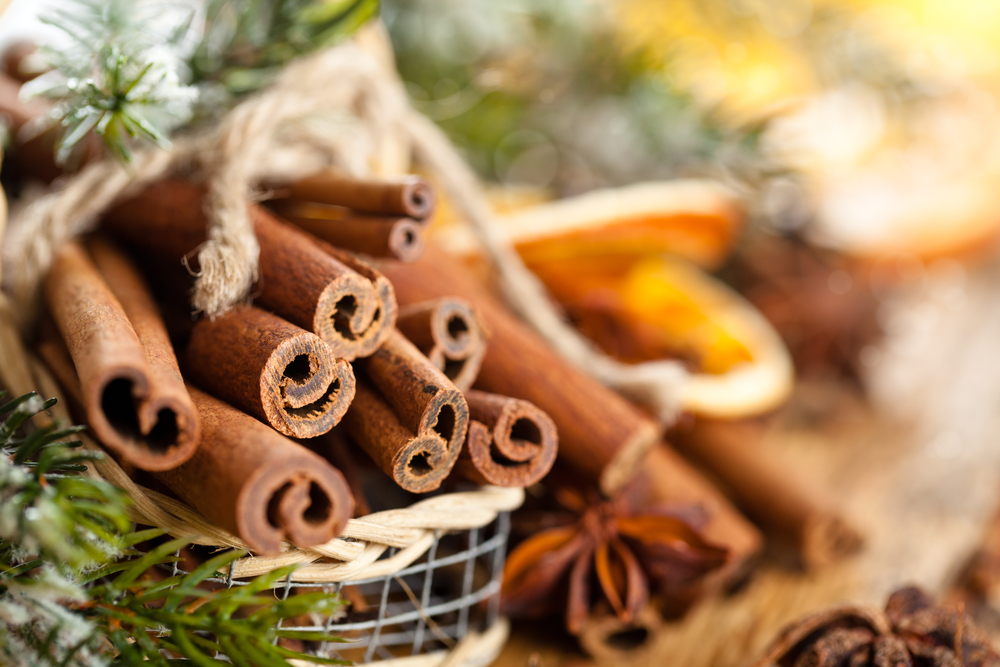
There are several herbs that are appropriate for small live Christmas trees. They add diversity to the season and are useful after the Christmas season. They are Rosemary, Greek Myrtle, and Bay Laurel. Rosemary is used in Europe because of the associations with Mary (the flowers changed from white to blue after she laid her cloak on it, and blue is the traditional church color associated with Mary). Additionally, it has a wonderful piney scent and makes a very small table tree.
![]() Rosemary — For remembrance, of course, and long associated with Mary. Rosemary was used during the Middle Ages by housewives to spread on the floor at Christmas. As people walked on it, a pleasant aroma arose. Tradition has it that the shrub is fragrant because Mary laid the garments of the Christ Child on its branches. The night he was born, legend has it, the trees suddenly bore fruit and flowers blossomed out of season.
Rosemary — For remembrance, of course, and long associated with Mary. Rosemary was used during the Middle Ages by housewives to spread on the floor at Christmas. As people walked on it, a pleasant aroma arose. Tradition has it that the shrub is fragrant because Mary laid the garments of the Christ Child on its branches. The night he was born, legend has it, the trees suddenly bore fruit and flowers blossomed out of season.
![]() Thyme — A manger herb signifying strength, courage and strength of Christ. Thyme is great in bean, egg and vegetable dishes, and along with fresh sprigs of parsley and bay leaves, thyme is included in “bouquet garni”, a French combination of herbs used to season stock, stews and soups.
Thyme — A manger herb signifying strength, courage and strength of Christ. Thyme is great in bean, egg and vegetable dishes, and along with fresh sprigs of parsley and bay leaves, thyme is included in “bouquet garni”, a French combination of herbs used to season stock, stews and soups.
![]() Rue — The herb of grace and banishes evil. In Sweden it is associated with St. Lucy and used to make crowns for celebrations of her December 13 saint’s day. The genus name “ruta” is derived from the Greek word “reuo”, that means “to set free”. No herb could be more appropriate in this setting where Christians believe the grace of God was bestowed on humanity. At one time brushes made of rue were used to sprinkle holy water before a Roman Catholic high mass and this ancient herb played an important role in that ceremony. Dehydrated leaves of the rue herb are said to have several therapeutic benefits and have been used as an anti-spasmodic to cure cramps, a calmative or sedative.
Rue — The herb of grace and banishes evil. In Sweden it is associated with St. Lucy and used to make crowns for celebrations of her December 13 saint’s day. The genus name “ruta” is derived from the Greek word “reuo”, that means “to set free”. No herb could be more appropriate in this setting where Christians believe the grace of God was bestowed on humanity. At one time brushes made of rue were used to sprinkle holy water before a Roman Catholic high mass and this ancient herb played an important role in that ceremony. Dehydrated leaves of the rue herb are said to have several therapeutic benefits and have been used as an anti-spasmodic to cure cramps, a calmative or sedative.
![]() Santolina (Dwarf Gray) — The herb of fair linen symbolizing swaddling cloth. Branches from this evergreen repel common household insects, including moths. Stems can be placed in drawers, under carpets, among books, and so forth. A tidier method is to add it to sachets, putting these in effective locations.
Santolina (Dwarf Gray) — The herb of fair linen symbolizing swaddling cloth. Branches from this evergreen repel common household insects, including moths. Stems can be placed in drawers, under carpets, among books, and so forth. A tidier method is to add it to sachets, putting these in effective locations.
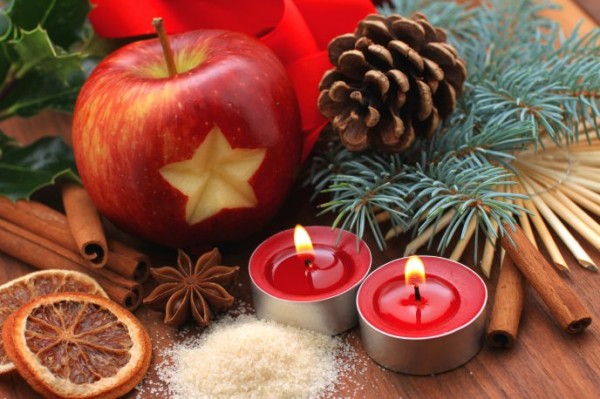
![]() Lavender — The symbol of purity, lavender is said to have received its lovely scent when it served as the drying rack for the Baby Jesus’ swaddling clothes. The word lavender (lavandula) is from the Latin word “lavare” meaning to wash. Legend has it that Mary laundered their clothing with this fragrant herb and used the bush as a clothes line. It further asserts that her clothes turned blue from contact with the flowers. In medieval Latin the usage of the word lavender changed and was derived from “livere” meaning “to make bluish.” Not incidentally blue is the color accorded to the Holy Mother in paintings and stories. Lavender plants were said to spring up wherever the swaddling clothes of the Holy Child were placed. It is no surprise that lavender is the herb symbolic of cleanliness, purity and immortality.
Lavender — The symbol of purity, lavender is said to have received its lovely scent when it served as the drying rack for the Baby Jesus’ swaddling clothes. The word lavender (lavandula) is from the Latin word “lavare” meaning to wash. Legend has it that Mary laundered their clothing with this fragrant herb and used the bush as a clothes line. It further asserts that her clothes turned blue from contact with the flowers. In medieval Latin the usage of the word lavender changed and was derived from “livere” meaning “to make bluish.” Not incidentally blue is the color accorded to the Holy Mother in paintings and stories. Lavender plants were said to spring up wherever the swaddling clothes of the Holy Child were placed. It is no surprise that lavender is the herb symbolic of cleanliness, purity and immortality.
![]() Bedstraw — Another manger herb; long used for forage in the Middle East. The honey like vapors activated by the heat of the body make yellow bedstraw (galium verum) a soothing, sweet smelling, resting place. It is said that the original white flowers turned their present golden color because of the manger’s special visitors. One legend tells us that before the birth of Christ, bedstraw had a white flower. Afterwards the flower changed to a deep gold color in recognition of the herb’s role in cradling the Savior.
Bedstraw — Another manger herb; long used for forage in the Middle East. The honey like vapors activated by the heat of the body make yellow bedstraw (galium verum) a soothing, sweet smelling, resting place. It is said that the original white flowers turned their present golden color because of the manger’s special visitors. One legend tells us that before the birth of Christ, bedstraw had a white flower. Afterwards the flower changed to a deep gold color in recognition of the herb’s role in cradling the Savior.
![]() Sage — the herb of immortality and domestic happiness. The story goes that Joseph and Mary strived to get away from Judea while hiding from Herod’s mercenaries. Seeing a rose bush in bloom nearby, Virgin Mary requested her for a place to hide but Rose, proudly refused to offer her any help, as then it would be in danger of being crushed by the soldiers. Ever since then, rose has thorns on it. Mary rushed to a clove bush nearby for help as it had plenty of flowers to hide her and the infant but she refused too saying she was too busy putting up blooms. Since then, clove has ill-smelling flowers. The only bush that remained was Sage plant. Sage was kind and charitable and when the Virgin approached her with a request to hide her and the baby, it readily blossomed abundantly and created a canopy for the Mother and the Child. The soldiers passed by them, without suspecting a thing. Since that time, the sage plant is considered sacred and is believed to possess many curative powers.
Sage — the herb of immortality and domestic happiness. The story goes that Joseph and Mary strived to get away from Judea while hiding from Herod’s mercenaries. Seeing a rose bush in bloom nearby, Virgin Mary requested her for a place to hide but Rose, proudly refused to offer her any help, as then it would be in danger of being crushed by the soldiers. Ever since then, rose has thorns on it. Mary rushed to a clove bush nearby for help as it had plenty of flowers to hide her and the infant but she refused too saying she was too busy putting up blooms. Since then, clove has ill-smelling flowers. The only bush that remained was Sage plant. Sage was kind and charitable and when the Virgin approached her with a request to hide her and the baby, it readily blossomed abundantly and created a canopy for the Mother and the Child. The soldiers passed by them, without suspecting a thing. Since that time, the sage plant is considered sacred and is believed to possess many curative powers.
![]() Costmary — called ‘Bible leaf’ and symbol of everlasting life. Costmary (chrysanthemum balsamita) with its sweet balsam scent is commonly called Bible Leaf or Our Lady’s Balsam. There are stories of its use as a healing ointment by the Holy Mother. Culpepper, an herbalist of the 1600’s, gives the following recipe for a healing salve. “Costmary makes an excellent salve … being boiled with oil of olive, and adder’s tongue with it, and after it is strained put a little wax, rosin and turpentine to bring it to convenient body.” Culpepper compares adder’s tongue to water plantain that herbalists now recommend for insect bites and sunburns. It is a wonder that something we use today may be a version of Mary’s own healing balm!
Costmary — called ‘Bible leaf’ and symbol of everlasting life. Costmary (chrysanthemum balsamita) with its sweet balsam scent is commonly called Bible Leaf or Our Lady’s Balsam. There are stories of its use as a healing ointment by the Holy Mother. Culpepper, an herbalist of the 1600’s, gives the following recipe for a healing salve. “Costmary makes an excellent salve … being boiled with oil of olive, and adder’s tongue with it, and after it is strained put a little wax, rosin and turpentine to bring it to convenient body.” Culpepper compares adder’s tongue to water plantain that herbalists now recommend for insect bites and sunburns. It is a wonder that something we use today may be a version of Mary’s own healing balm!
Costmary facial cleanserCrush one ounce of fresh costmary in two cups of water. Pour into a ceramic pot. Cover and simmer for five minutes. Keep covered and allow it to cool. Strain and store in the refrigerator. Use as an astringent after washing your face by gently dabbing it on with a cotton ball. |
![]() Horehound—giving good health. They are now used primarily as flavorings in liqueurs, candies, and cough drops. Extracts of the plant have also been used for treating intestinal parasites, as a diaphoretic, and as a diuretic.
Horehound—giving good health. They are now used primarily as flavorings in liqueurs, candies, and cough drops. Extracts of the plant have also been used for treating intestinal parasites, as a diaphoretic, and as a diuretic.
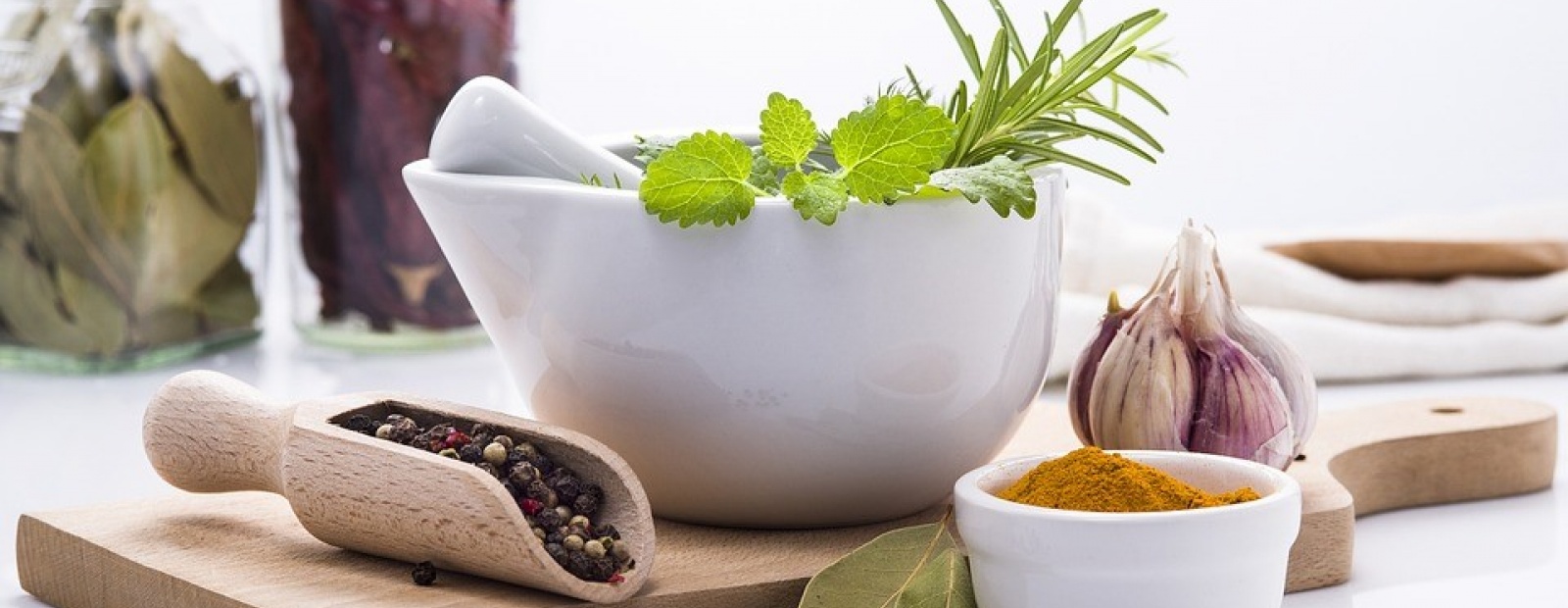
![]() Pennyroyal—One of the manger herbs. In addition to its pleasant aroma, it repels insects. Its action is carminative, diaphoretic, stimulant and emmenagogic, and is principally employed for the last-named property in disorders caused by sudden chill or cold. It is also beneficial in cases of spasms, hysteria, flatulence and sickness, being very warming and grateful to the stomach.
Pennyroyal—One of the manger herbs. In addition to its pleasant aroma, it repels insects. Its action is carminative, diaphoretic, stimulant and emmenagogic, and is principally employed for the last-named property in disorders caused by sudden chill or cold. It is also beneficial in cases of spasms, hysteria, flatulence and sickness, being very warming and grateful to the stomach.
Festive arrangements with dried and preserved materials always look especially lovely at Christmas and other holiday times. Dried herbs blend in very well with more traditional Christmas decorations such as pine cones, nuts and cinnamon sticks. Gilded poppy heads mixed with bunches of roses, purple marjoram, gilded cones and dark burgundy tartan ribbons look amazing. As there are many presents given and parties to go to during this festive season, this is a good opportunity to give something just a little out of the ordinary.
Disclaimer
The Content is not intended to be a substitute for professional medical advice, diagnosis, or treatment. Always seek the advice of your physician or other qualified health provider with any questions you may have regarding a medical condition.
